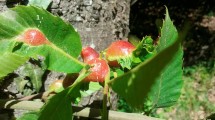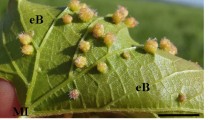Abstract
Species, varieties, and hybrids of Vitis are differently susceptible to feeding by the aphid Daktulosphaira vitifoliae (Fitch) (Hemiptera: Phylloxeridae). The differing levels of susceptibility were examined in Vitis riparia × V. rupestris cv. C-3309, V. vinifera × V. labrusca cv. Weiβe Amerikaner, and V. vinifera cv. Portugieser Weiβherbst by characterizing early subcellular changes to aphid feeding. We examined the fifth and sixth layers of mesophyll parenchyma between 3 and 48 h after introducing neonate nymphs of D. vitifoliae on to those leaves. In the susceptible variety C-3309, activated and metaplasied cells appeared in 3–6 h of feeding by D. vitifoliae and developed into nutritive tissue in the next 24–48 h. On the contrary, cells of the resistant variety Portugieser Weiβherbst accumulated phenolic materials indicating a hypersensitive response; those of Weiβe Amerikaner showed a mixed response of developing a nutritive tissue and a concurrent accumulation of phenolic materials especially in cells away from the nutritive tissue, indicating that this hybrid could tolerate D. vitifoliae. Galls developed on the leaves of C-3309 in 21 days, whereas no gall development occurred on the leaves of Portugieser Weiβherbst and Weiβe Amerikaner. D. vitifoliae nymphs introduced on the leaves of Portugieser Weiβherbst died in 3–4 days, whereas on the leaves of Weiβe Amerikaner, nymphs lived up to 21 days. Thus early subcellular changes in leaf tissues determined the feeding activity of nymphs on leaves and the susceptibility of plants to insect feeding.
Zusammenfassung
Blätter verschiedener Rebsorten reagieren unterschiedlich auf den Befall mit der Reblaus Daktulosphaira vitifoliae (Fitch). Hier wurde die Reaktion der Sorten Vitis riparia × V. rupestris cv. C-3309, V. vinifera × V. labrusca cv. Weiβe Amerikaner und V. vinifera cv. Portugieser Weiβherbst (kurz: C-3309, Weiβe Amerikaner und Portugieser Weiβherbst) verglichen, um die unterschiedliche Empfindlichkeit zu verstehen. Dazu wurden frühe subzelluläre Veränderungen der Blattgewebe in aseptischen Dualkulturen aus Vitis und D. vitifoliae charakterisiert. Da die Stechborsten der jungen Nymphen von D. vitifoliae bis in die fünfte oder sechste Mesophyllschicht von C-3309 eindringen, wurden Zellen dieser Schichten bei allen drei Rebsorten 3–48 Stunden nach Zugabe der Nymphen beobachtet. Bei der Sorte C-3309 erfolgte eine Differenzierung von aktivierten und metaplasierten Zellen 3–6 Stunden nach dem Befall. In den folgenden 24–48 Stunden entwickelten sich diese Zellen zu einem Nährgewebe; somit erfolgte eine kompatible Reaktion. Im Gegensatz dazu zeigten die Zellen der Sorte Portugieser Weiβherbst eine hypersensitive Reaktion mit Akkumulation phenolischer Verbindungen. Zellen der Sorte Weiβe Amerikaner reagierten sowohl mit der Bildung von Nährzellen als auch mit der Akkumulation phenolischer Verbindungen ausserhalb der Nährzellen; dies ist ein Zeichen für Toleranz. Die Entwicklung typischer Gallen erfolgte in 21 Tagen ausschliesslich an den Blättern der Sorte C-3309. An Portugieser Weiβherbst starben die Nymphen innerhalb von 3–4 Tagen ab, an Blättern von Weiβe Amerikaner überlebten sie bis zum 21 Tag, ohne dass eine Gallbildung erfolgte. Die frühen subzelluläre Veränderungen der Blattgewebe bestimmten somit die Frasstätigkeit der Nymphen und die Empfindlichkeit der drei Rebsorten auf den Insektenbefall.




Similar content being viewed by others
References
Abrahamson WG, Melika G, Scrafford R, Csóka G (1998) Gall-inducing insects provide insights into plant systematic relationships. Am J Bot 85:1159–1165
Askani A, Beiderbeck R (1991) In vitro propagation of Daktulosphaira vitifoliae Fitch (Homoptera: Phylloxeridae) on shoot and root cultures of a Vitis hybrid. Vitis 30:223–232
Bisson LF, Waterhouse AL, Ebeler SE, Walker MA, Lapsley JT (2002) The present and future of the international wine industry. Nature 418:696–699
Bronner R (1992) The role of nutritive cells in the nutrition of cynipids and cecidomyiids. In: Shorthouse JD, Rohfritsch O (eds) Biology of insect-induced galls. Oxford University Press, New York, pp 118–140
Després L, David J-P, Gallet C (2007) The evolutionary ecology of insect resistance to plant chemicals. Trends Ecol Evol 22:298–307
El–Nady MF, Schröder M–B (2003) Cytology of the hypersensitivity reaction in rootstocks—improvement of rootstock breeding. Acta Hortic 617:17–23
Fabbri AA, Fanelli C, Reverberi M, Ricelli A, Camera E, Urbanelli S, Rossini A, Picardo M, Altamura MM (2000) Early physiological and cytological events induced by wounding in potato tuber. J Exp Bot 51:1267–1275
Fink S (1999) Pathological and regenerative plant anatomy (Handbuch der Pflanzenanatomie, XII). Bornträger, Stuttgart
Forneck A, Walker MA, Blaich R (2001) An in vitro assessment of phylloxera (Daktulosphaira vitifoliae Fitch) (Hom., Phylloxeridae) life cycle. J Appl Entomol 125:443–447
Forneck A, Kleinmann S, Blaich R, Anvari SF (2002) Histochemistry and anatomy of phylloxera (Daktulosphaira vitifoliae) nodosities on young roots of grapevine (Vitis spp.). Vitis 41:93–97
Gatehouse JA (2002) Plant resistance towards insect herbivores: a dynamic interaction. New Phytol 156:145–169
Granett J, Walker MA, Kocsis L, Omer AD (2001) Biology and management of grape phylloxera. Annu Rev Entomol 46:387–412
Hardie WJ, O’Brien TP, Jaudzems VG (1996) Morphology, anatomy and development of the pericarp after anthesis in grape, Vitis vinifera L. Aust J Grape Wine Res 2:97–142
Heath MC (1998) Apoptosis, programmed cell death and the hypersensitive response. Eur J Plant Pathol 104:117–124
Kellow AV, Sedgely M, van Heeswijck R (2004) Interaction between Vitis vinifera and grape phylloxera: changes in root tissue during nodosity formation. Ann Bot 93:581–590
Kingston KB, Powell KS, Cooper PD (2007) Grape phylloxera external morphology: observations under scanning electron microscopy. Acta Hortic 733:107–114
Konno H, Nakato T, Tsumuki H (2003) Altered matrix polysaccharides in cell walls of pocket galls formed by an aphid on Distylium racemosum leaves. Plant Cell Environ 26:1973–1983
Mello MO, Silva-Filho MC (2002) Plant–insect interactions: an evolutionary arms race between two distinct defense mechanisms. Braz J Plant Physiol 14:71–81
Meyer J (1987) Plant galls and gall inducers. Bornträger, Stuttgart
Meyer J, Maresquelle H–J (1983) Anatomie des galles (Handbuch der Pflanzenanatomie, XIII:1). Bornträger, Stuttgart
Miles PW (1999) Aphid saliva. Biol Rev 74:41–85
Ollerstam O, Rohfritsch O, Höglund S, Larsson S (2002) A rapid hypersensitive response associated with resistance in the willow Salix viminalis against the gall midge Dasineura marginemtorquens. Entomol Exp Appl 102:153–162
Olmos E, Kiddle G, Pellny TK, Kumar S, Foyer CH (2006) Modulation of plant morphology, root architecture, and cell structure by low vitamin C in Arabidopsis thaliana. J Exp Bot 57:1645–1655
Paul ND, Hatcher PE, Taylor JE (2000) Coping with multiple enemies: an integration of molecular and ecological perspectives. Trends Plant Sci 5:220–225
Pearson RC, Goheen AC (1988) Compendium of grape diseases. APS Press, St Paul
Raman A (1996) Nutritional diversity in gall-inducing insects and their evolutionary relationships with flowering plants. Int J Ecol Environ Sci 22:150–160
Raman A, Schaefer CW, Withers TM (2005) Galls and gall-inducing arthropods: an overview of their biology, ecology, and evolution. In: Raman A, Schaefer CW, Withers TM (eds) Biology, ecology, and evolution of gall-inducing arthropods. Science Publishers, New Hampshire, pp 1–33
Repka V, Fischerová I, Šilhárová K (2001) Methyl jasmonate induces a hypersensitive-like response of grapevine in the absence of avirulent pathogens. Vitis 40:5–10
Rohfritsch O (1977) Ultrastructure of the nutritive tissue of the Chermes abietis L. fundatrix on Picea excelsa L. Marcellia 40:135–150
Rohfritsch O (1988) A resistance response of Picea excelsa to the aphid, Adelges abietes (Homoptera: Aphidoidea). In: Mattson WJ, Levieux J, Bernard–Dagan C (eds) Mechanisms of woody plant defenses against insects: search for pattern. Springer, Heidelberg, pp 253–266
Rohfritsch O (1999) A so-called ‘rudimentary gall’ induced by the gall midge Physemocecis hartigi on leaves of Tilia intermedia. Can J Bot 77:460–470
Rohfritsch O, Anthony M (1992) Strategies of gall induction by two groups of homopterans. In: Shorthouse JD, Rohfritsch O (eds) Biology of insect-induced galls. Oxford University Press, New York, pp 102–117
Roush TL, Granett J, Walker MA (2007) Inheritance of gall formation relative to phylloxera resistance levels in hybrid grapevines. Am J Enol Vitic 58:234–241
Ruthmann A (1970) Methods in cell research. Cornell University Press, Ithaca
Sharma SS, Sharma S, Rai VK (1990) Interference of ascorbic acid with the starch–iodine reaction. Ann Bot 65:281–283
Shorthouse JD, Wool D, Raman A (2005) Gall-inducing insects—nature’s most sophisticated herbivores. Basic Appl Ecol 6:407–411
Singh DP, Singh A (2005) Disease and insect resistance in plants. Science Publishers, New Hampshire
Sterling C (1952) Ontogeny of the phylloxera gall of grape leaf. Am J Bot 39:6–15
Stout MJ (2007) Types and mechanisms of rapidly induced plant resistance to herbivorous arthropods. In: Walters D, Newton A, Lyon GD (eds) Induced resistance for plant defence. Blackwell, Melbourne, pp 85–107
Tjallingii WF, Hogen-Esch T (1993) Fine structure of aphid stylet routes in plant tissue in correlation with EPG signals. Physiol Entomol 18:317–328
Valette C, Andary C, Geiger JP, Sarah JL, Nicole M (1998) Histochemical and cytochemical investigations of phenols in roots of banana infected by the burrowing nematode Radopholus similis. Phytopath 88:1141–1148
Wapshere AJ, Helm KF (1987) Phylloxera and Vitis: an experimentally testable coevolutionary hypothesis. Am J Enol Vitic 38:216–222
Wool D (2005) Gall-inducing aphids: biology, ecology, and evolution. In: Raman A, Schaefer CW, Withers TM (eds) Biology, ecology, and evolution of gall-inducing arthropods. Science, New Hampshire, pp 73–132
Zhu–Salzman K, Salzman RA, Ahn J-E, Koiwa H (2004) Transcriptional regulation of sorghum defense determinants against a phloem-feeding aphid. Plant Physiol 134:420–431
Acknowledgments
We thank David Wool (Tel-Aviv University, Ramat Aviv, Israel) and Odette Rohfritsch (Institut de Biologie Moléculaire des Plantes, Strasbourg, France) for reading an earlier draft. We also thank Reynar Schill (Biodiversity and Plant Systematics, Heidelberg Institute of Plant Sciences, Heidelberg, Germany) for the use of the scanning electron microscope, Beate Schöfer and Rose-Marie Hohl (Molecular Ecophysiology, Heidelberg Institute of Plant Sciences, Heidelberg, Germany) for help with sample preparations. A. Raman thanks Deutscher Akademischer Austauschdienst (DAAD) for supporting his visit to the Heidelberg Institute of Plant Sciences.
Author information
Authors and Affiliations
Corresponding author
Additional information
Responsible Editor: Sabine Güsewell.
Rights and permissions
About this article
Cite this article
Raman, A., Beiderbeck, R. & Herth, W. Early subcellular responses of susceptible and resistant Vitis taxa to feeding by grape phylloxera Daktulosphaira vitifoliae . Bot. Helv. 119, 31–39 (2009). https://doi.org/10.1007/s00035-009-0054-4
Received:
Accepted:
Published:
Issue Date:
DOI: https://doi.org/10.1007/s00035-009-0054-4




